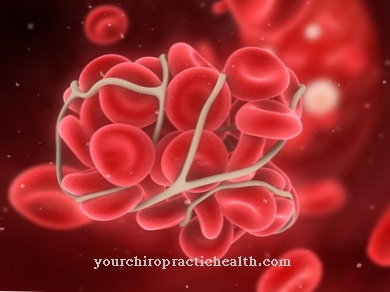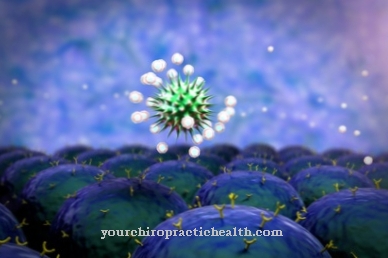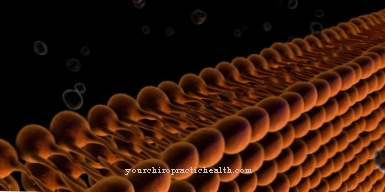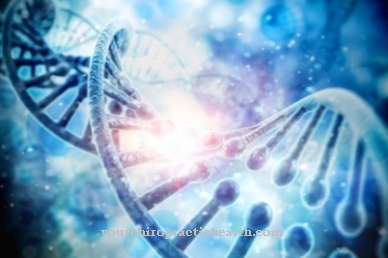Of the gastrocolic reflex is an irritant response of the large intestine that occurs when the stomach is irritated. The gastrocolic reflex causes the large intestine to contract and the contents of the large intestine are pushed forward towards the rectum.
What is the gastrocolic reflex?

In the gastrocolic reflex, the large intestine reacts to irritation of the stomach and upper digestive organs. The term reflex is actually not entirely correct, as it is rather a stimulus response of the large intestine. An actual reflex is much faster.
As a rule, the gastrocolic reflex is triggered by ingesting food and causes so-called mass movements in the colon. These move the intestinal contents towards the rectum and ultimately ensure that the bowel is emptied.
Function & task
In order to understand the gastrocolic reflex, knowledge of the digestive process is necessary. The first digestion of the food takes place in the mouth. Here the food is chopped up by the teeth and made lubricious by saliva. The chyme then reaches the stomach via the esophagus.
There it is collected for a long time. The lining of the stomach contains different types of cells, all of which play an important role in digestion. The secondary cells produce mucus to protect the mucous membrane, the parietal cells produce hydrochloric acid and the so-called intrinsic factor, and the main cells produce pepsinogens. These are important for protein digestion.
The actual digestion begins in the stomach. In addition, the chyme is mixed there and pressed through the stomach outlet into the small intestine. Carbohydrate, protein and fat digestion take place in the small intestine, especially in the duodenum. In addition, water is removed from the chyme here. Up to 80% water, consisting of digestive juices and fluids from the ingested food, is absorbed here.
The chyme then moves from the small intestine to the large intestine. The large intestine shows a structure typical of the gastrointestinal tract. The innermost layer, a mucous membrane, is covered with loose connective tissue. This is followed by a circular muscle layer and a longitudinal muscle layer. There is a plexus of nerves between the muscle layers. This is also known as the myenteric plexus. The myenteric plexus is responsible for the muscle activity of the digestive organs, in particular for the muscle activity of the intestine. The longitudinal muscle layer of the intestine is thickened into three strands called tänien. The circular muscle layer shows indentations. There the intestinal wall forms bulges. These bulges are known as house doors. The tänien and house doors characteristic of the large intestine support the peristalsis of the intestine.
In the colon, a distinction is made between non-propulsive and propulsive peristalsis. Non-propulsive peristalsis consists of ring-shaped contractions. It serves to mix the food in the intestine. Propulsive peristalsis is characterized by involvement of the longitudinal muscles. It is used to transport the intestinal contents towards the anus.
There are stretch receptors in the wall of the mouth, esophagus, and stomach. When eating, the wall of these organs is stretched and the receptors are excited. This information is now passed on to the colon on the one hand via the autonomic nervous system and on the other via the myenteric plexus. This reacts with strong contractions and increased propulsive peristalsis. As a result, the chyme in the large intestine is pushed further and further towards the rectum.
There, the urge to defecate is triggered by the stretching of the rectal wall and, ideally, a bowel movement follows. Simply put, the gastrocolic reflex ensures that space is made in the colon for the digestion of the newly ingested food.
You can find your medication here
➔ Medication for constipation and intestinal problemsIllnesses & ailments
As a result, a disturbed gastrocolic reflex leads to digestive disorders. A congenital disorder of the gastrocolic reflex is found in Jirásek-Zuelzer-Wilson syndrome. The affected persons lack the nerve cells of the myenteric plexus in the colon wall. This shows an expansion of the intestine. This is also known as a megacolon. In addition, the stool cannot properly pass through the large intestine. Sick people already suffer from a bloated stomach in infancy and have problems defecating.
A characteristic feature is the delayed withdrawal of the meconium after birth. The meconium, also popularly known as Kindspech, is the baby's first bowel movement. The diagnosis is made using X-rays and a histological examination of the colon tissue. Often the newborn has to have an artificial anus placed a few days after birth. The chair passage may have to be surgically restored.
A similar disease of the intestine with a disturbed gastrocolic reflex is Hirschsprung's disease. Here, too, nerve cells in the area of the myenteric plexus are missing. In addition, there are more nerve cells that are responsible for stimulating the circular muscles. This leads to a permanent excitation of the circular muscles with simultaneous nervous undersupply of the longitudinal muscles.
The circular muscles contract and constrict the intestines. An intestinal obstruction develops. Due to the lack of a gastrocolic reflex, the intestinal contents are not transported further. The bowel can no longer be emptied. The result is very severe blockages. The intestine expands due to the accumulation of feces and the megacolon also occurs here. As with the Jirásek-Zuelzer-Wilson syndrome, the child's bad luck does not come off or goes away very late.
An increased gastrocolic reflex can also cause problems. Especially newborns and patients with irritable bowel syndrome are affected by an increased gastrocolic reflex. Usually, the gastrocolic reflex causes stool to evacuate within 30 to 60 minutes of eating. With an increased gastrocolic reflex, those affected often have to go to the toilet while they are eating. The premature urge to stool is accompanied by violent abdominal cramps. Diarrhea often occurs. Newborns with an increased gastrocolic reflex often refuse to eat completely because of the extremely painful intestinal cramps.
















.jpg)
.jpg)



.jpg)






